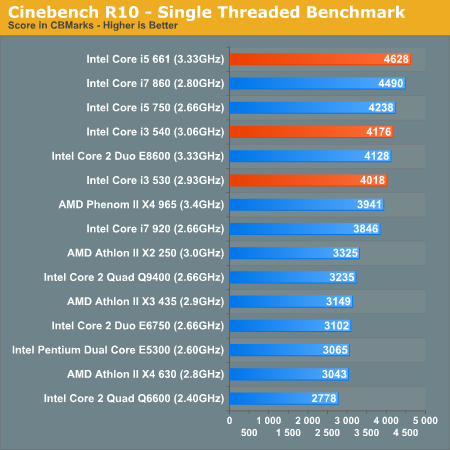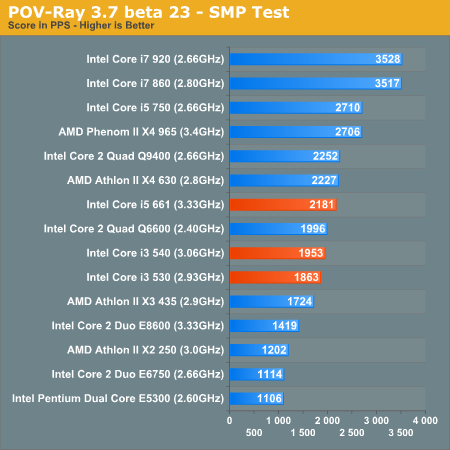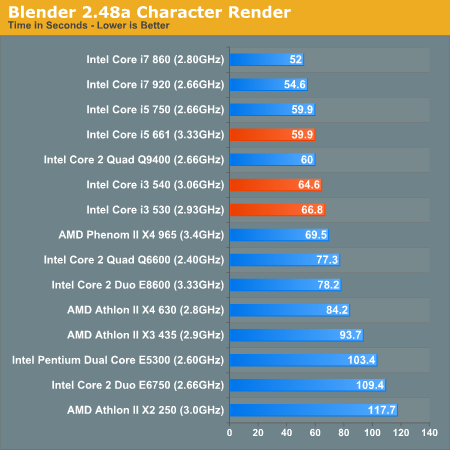The Clarkdale Review: Intel's Core i5 661, i3 540 & i3 530
by Anand Lal Shimpi on January 4, 2010 12:00 AM EST- Posted in
- CPUs
3dsmax 9 - SPECapc 3dsmax CPU Rendering Test
Today's desktop processors are more than fast enough to do professional level 3D rendering at home. To look at performance under 3dsmax we ran the SPECapc 3dsmax 8 benchmark (only the CPU rendering tests) under 3dsmax 9 SP1. The results reported are the rendering composite scores:

As with video encoding, this sort of test greatly benefits from more CPU cores. The 661 places just below the Q9400 while the i3 parts place at or below the level of an old Q6600. All the new parts are faster than the Core 2 Duo CPUs, but that's as good as it gets.
Cinebench R10
Created by the Cinema 4D folks we have Cinebench, a popular 3D rendering benchmark that gives us both single and multi-threaded 3D rendering results.

Clarkdale's saving grace is its single threaded performance. The 661 can run at up to 3.60GHz when only a single thread is active, giving it better single threaded performance than anything else on the chart here. The majority of desktop performance is still bound by the performance of a single thread. That's where Clarkdale will shine.
Even the turbo-less i3s do very well here despite their "low" clock speed. The i3 530 is almost as fast as a 3.33GHz Wolfdale and slightly faster than a Phenom II 965. The low latency L2 helps Clarkdale a lot here.

There's no substitution for more cores. Run four CPU intensive threads and Clarkdale loses its edge.
POV-Ray 3.73 beta 23 Ray Tracing Performance
POV-Ray is a popular, open-source raytracing application that also doubles as a great tool to measure CPU floating point performance.
I ran the SMP benchmark in beta 23 of POV-Ray 3.73. The numbers reported are the final score in pixels per second.

POV-Ray is the worst for Clarkdale. Even the Athlon II X4 630 can outperform the i5 661. The i3s are pretty close in performance to the 661 though, they at least offer a better value.
Blender 2.48a
Blender is an open source 3D modeling application. Our benchmark here simply times how long it takes to render a character that comes with the application.

Blender is the opposite of POV-Ray, showing more of a best-case for 3D rendering on Clarkdale. The 661 still doesn't make sense based on price, but the i3 parts surpass everything except the Q9400 in this test.










93 Comments
View All Comments
yuhong - Monday, January 4, 2010 - link
"The Clarkdale lineup is honestly made up of CPUs that are too expensive. The Core i5 670, 661/660 and 650 are all priced above $170 and aren’t worth the money. The problem is Lynnfield’s turbo mode gives you high enough clock speeds with two threads that there’s no need to consider a dual-core processor. You can buy a Core i5 750, have more cores than any of these Clarkdales and run at close enough to the same frequencies for $196."But then you have to pay extra for a discrete graphic card and not every application need the extra graphic power!
Paulman - Monday, January 4, 2010 - link
Wow, I was going to write about how you wouldn't have to buy a discrete graphics card if you went with a Core i5 750 because you could just choose a motherboard with an integrated graphics chip. But then I checked online and it seems that there aren't any P55-based boards with integrated graphics - wow! Wouldn't have believed it myself.However, Anand's point still stands when comparing the Clarkdale i5's to the Phenom II X4, for which you can get many boards with integrated graphics.
Inkie - Sunday, January 10, 2010 - link
"when comparing the Clarkdale i5's to the Phenom II X4, for which you can get many boards with integrated graphics"...but Clarkdale already has integrated graphics.
ssj4Gogeta - Friday, January 8, 2010 - link
It's because P55 is a southbridge, not a northbridge.Taft12 - Monday, January 4, 2010 - link
But then you have to pay extra for a discrete graphic card and not every application need the extra graphic power!Only if you don't already have any PCI-E x16 card. Is that true for a single reader of this site? And truly ANY PCI-E card will perform better than Intel's on-chip solution, even one 3 generations old.
ereavis - Monday, January 4, 2010 - link
so the price goes up another $30-$40. As to your question of truth, yes I spend 40 hours a week on an intel IGP dual core as it is, so do the other 1000 people in this building doing engineering work that's processor demanding but graphics independent.nubie - Monday, January 4, 2010 - link
There are rafts of HP 8400 OEM pci-e cards on ebay right now for $15 (total, no shipping or tax), that should even accelerate your Flash 10.1 and video just fine.If you even need it that is, and it is clear that for many there is absolutely no use for more than the integrated graphics.
oc3an - Monday, January 4, 2010 - link
Hi Anand. Looks to me like something weird is up with your Everest benchmarks. Shouldn't the 24X multiplier have the faster scores?-Patrick
Rajinder Gill - Monday, January 4, 2010 - link
Hi Patrick,Fixed it, the images were reversed.
Thanks!
Raja
maxfisher05 - Monday, January 4, 2010 - link
Good Article Anand. I'm going to be building my first HTPC soon, but I want to be able to do some light gaming on it, and it doesn't look like the integrated graphics have come far enough yet. If the 661 was priced lower I would consider it, but for nearly the price of a 750 you are right in saying it makes no sense. 750 + 5750 discrete graphics for me please :)Will someone be posting an updated system buyers' guide soon?